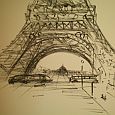Illustrations in rare books have their origins in three basic print methods: Relief printing, Intaglio and Planographic printing.The difference between Relief, Intaglio and Planographic printing is in the use of the printing plate or block. Relief print is a printmaking process where protruding surface faces of the block are inked; recessed areas are ink free. Woodcuts and typeset printing are examples of this method. In intaglio, the recessed areas are the printed areas as in engravings, etchings and drypoints. Planographic printing means printing from a flat surface, as opposed to a raised surface or incised surface. Lithographs are examples of this method.
Woodcut is the oldest technique used for old master prints, developed around 1400. The method involves image carving into the surface of a block of wood, with the printing parts remaining level with the surface while the non-printing parts are removed. Rare books containing woodcuts are sometimes described by museums as “designed by” rather than “by” an artist; This is because the task usually involved in addition to the artist a woodworking specialist that produced the cutting of the drawing on a wood block. Compared to the intaglio techniques little pressure is required in order to print.
Engraving was a historically important method of producing images on paper to form illustrations for books. It has long been replaced by various photographic processes and other techniques. Intaglio engraving (gravure), as a method of making prints, was invented in Germany by the 1430s, well after the woodcut print.
Drypoint and etching were also German inventions of the fifteenth century, probably by the Housebook Master and Daniel Hopfer respectively. The golden age of artists engraving was 1450–1550, after which the technique lost ground to easier mediums such as etching and drypoint. Today intaglio engraving can be found decorating a number of books from the beginning of the 21st century up till the middle of the centuray or there about. The 17th century was the great age of etching, with Rembrandt, Giovanni Benedetto Castiglione and many other masters. In the 18th century, Piranesi, Tiepolo and Daniel Chodowiecki were the best of a smaller number of fine etchers. In the 19th and early-20th century the Etching revival produced a host of lesser artists.
Lithography originally used an image drawn (etched) into a coating of wax or an oily substance applied to a plate of lithographic stone as the medium to transfer ink to a blank paper sheet, and so produce a printed page. Most types of books of high-volume text are printed with offset lithography, the most common form of printing technology. The term plate in book design was actually derived from the lithographic use, where mass produced images were printed separately then bound into the book in groups.
I hope you will enjoy the following Rare Books Digest presentation.

{ 0 comments… add one now }
{ 1 trackback }